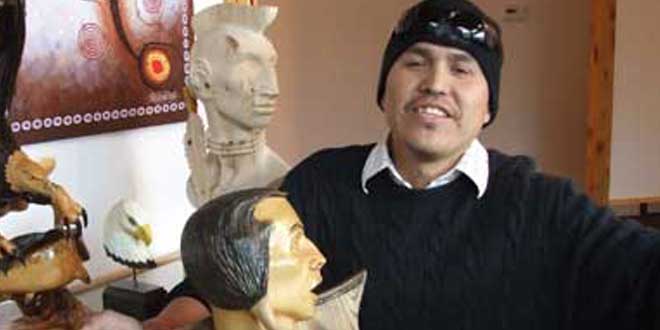M’CHIGEENG—Christopher Lee Bebonang is a Anishinabe carver of considerable talent, which is self-evident to anyone stepping into the foyer of the Ojibwe Cultural Foundation building in M’Chigeeng where his work has been on display recently. What isn’t self-evident is the role that the methadone program in M’Chigeeng has played in helping Mr. Bebonang reclaim his life from the clutches of opiate addiction.
“I can honestly say that if it wasn’t for Dr. Brian Dressler and the methadone program I would probably be dead by now,” he said.
Mr. Bebonang slipped into a lifestyle that centred on drugs and alcohol during high school. “I would say it was peer pressure,” he said. “It seemed like everybody was doing it. After a while I was hooked on drugs.” But the lifestyle was viewed through a third person haze. That person getting high and drinking every day wasn’t the person Chris Bebonang had been.
The Chris Bebonang he knew was shy and had difficulty mixing with people. When pot and booze took over, the inhibitions fell away and Mr. Bebonang became somebody else. “At first it was mostly marijuana and alcohol,” he said. An avid hockey player, Mr. Bebonang envisioned himself following that career path. “I was always into art, but it was kind of like my second choice,” he said. Then, about six years ago, he hurt his shoulder.
Soon he found that he needed more of the painkillers than he was getting. “I thought it was helping me,” he said. “Opiates and marijuana.”
Soon he was pretty much stoned all the time—walking through life in a haze. “Before this (sober and clean through the methadone program) if you saw me on the street, 90 percent of the time I would be high,” Mr. Bebonang said. “Because of drugs and alcohol, I missed a lot of things in life.”
When Mr. Bebonang decided to make a change in his life and enter the methadone program he stepped away from his girlfriend, who stayed in the lifestyle. “She died,” he said. “It was a drug overdose, but not from methadone.” Had he not left the lifestyle, Mr. Bebonang said he was convinced he would also be dead by now.
He described the moment he decided to step away from drugs as being one moment of clarity. “I was working in a school and the kids in the classes knew who I was out on the street and that I had a reputation as being someone you could get stuff from,” he said. “They would come up to me and want me to get them stuff. I never sold to kids,” said Mr. Bebonang. “But the people who were coming to me kept getting younger and younger. I could never sell to them.” But having young people approach him for drugs forced Mr. Bebonang to reevaluate his priorities in life and who he had become. “I did not want to be that kind of influence,” he said.
Now, Mr. Bebonang said, he feels like he has been given a second lease on life.
“I am getting a chance to do those things again,” he said. “Before, when I was using, I would never have thought that I would be at a point in my life where I would see everything different, that I would look forward to a natural high.”
Walking in the woods, breathing in fresh air, the charge he gets with being connected with life, rather than looking at the world through a thick haze of alcohol and drugs, have become the focus of his life, he said, and that life is starting to send more and more positive things his way.
“It seems like opportunity comes knocking when you give it a chance,” he said. He described the positive charge he got from having his art work included in a recent artistic display at the Six-foot Art Festival at Debajehmujig. “Things like that with Diane (Bebonang) start happening.” Instead of being focussed on his next fix, or hustling to sell pills given to him to peddle by those with legitimate prescriptions, Mr. Bebonang finds himself looking forward to the next stop on his journey through life.
“Without someone like Dr. Dressler and the methadone program I would never have been able to get out of that life,” he said. Mr. Bebonang credits having the program near his home with helping him stay on the path. “If they had moved it to Sudbury, like they did for the people in Wikwemikong, I don’t think I would have stayed in the program if I had to travel to Sudbury. I probably would have relapsed.”
The Little Current methadone clinic closed earlier this year after a short acrimonious sojourn on that town’s main street.
He notes that the demand for the program should be even higher than it is. “For the 15 people in the program,” he said, “not even 10 percent of the people in the community who abuse opiates are in it.”
Mr. Bebonang said he was also very grateful to pharmacist Michael Bondi and “the beautiful women in the store” for being so considerate and friendly to him when he goes into the facility. “They always greet us with a big smile,” he said.
“Robert Beaudin at the (M’Chigeeng) health centre has been very helpful,” said Mr. Bebonang. “He has given us the option to talk to a counsellor. He has made it possible for us do this here in our own community. Having someone to talk to helps at times.”
Mr. Bebonang studied fine arts at the White Mountain Academy in Elliot Lake and when it comes to his art he works primarily in woodcarving. “I like cedar, antlers, bone and soapstone,” he said. “But I like cedar the best.”
His favourite subjects are animals. “I like the animals from around here, local animals, the ones that are natural to our area,” he said.

Mr. Bebonang said that he credits local artists like Blake Debassige of M’Chigeeng, Billy Bondi of Wikwemikong, Gordie Waindubence of Sheguiandah, as well as Ken Ense and Dave Wemigwans of M’Chigeeng as major influences along with the Group of Seven and Tom Thomson. Because although he sees himself as drawing inspiration from his Native culture and traditions, he does not want to be limited or pigeon-holed into any limiting slots. “People ask me to do totems and Innuit art, but that isn’t what I do. I like my own style, kind of responding to the way I used to be,” he said.
Mr. Bebonang said that he hopes that he can become a positive influence in the lives of young people.
“I want to show younger people that there is hope,” he said. “That if you let positive things come into your life, they will. If I can do it, they can too.”
“I don’t think it would be a good thing for me to have too much money right now,” he said, declining to provide his phone number or contact information for the article. One step at a time, he wants to have a longer stretch of sobriety in front of him before he moves that far down the line.Mr. Bebonang said he is empowered by not being in any hurry to find wealth and fame with his art. “I think that a lot of people are caught up in making big money right away,” he said. “I think the art suffers for that.”
Looking over a collection of his past works, one thing seems clear, Mr. Bebonang will have little trouble finding people willing to help him clear any backlog of artwork he may find cluttering up his home studio.
For now, though, he just wants to get a message out to people who once stood where he did. “There is hope and there is opportunity,” he said. “Just open that door and let people help you find your way back.”





